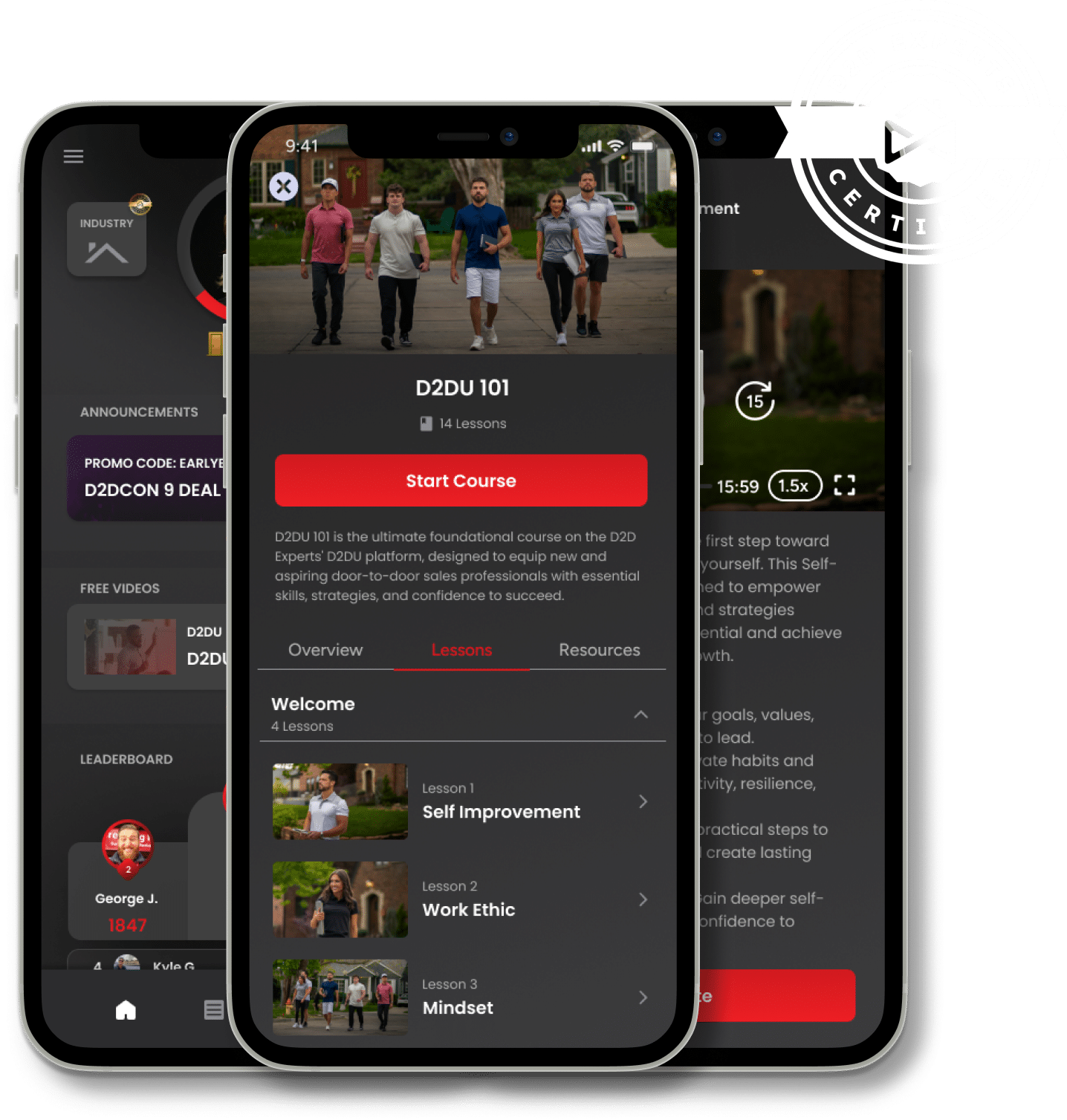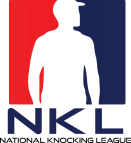Knocking on doors and pitching a roof replacement isn’t always easy, but a well-crafted roof sales pitch can be the difference between a polite “not interested” and a signed contract. Whether you’re selling a new roof to a homeowner after a storm or convincing a business to upgrade, how you deliver your pitch makes the effort successful or NOT.
Close More Roofing Deals!
Learn to Craft High-Converting Pitches with D2D University.

According to Sam Taggart, founder of D2D Experts,
“The ability to confidently present, educate, and close is what sets the top performers apart.”
Let’s talk about the key elements of a winning roofing pitch, common objections, and real-world examples to help you boost your closing rates and sell more roofs door-to-door.
Key Elements of a Successful Roof Sales Pitch
A winning roof sales pitch isn’t just about selling a service—it’s about solving problems, building trust, and guiding the customer toward an informed decision.
Here’s what makes a great pitch:
1. Personalization – Tailor the Pitch to the Customer’s Needs
Ask the right questions:
A great pitch isn’t one-size-fits-all. Start by asking specific questions to understand what matters most to the homeowner:
- “Have you had any roof issues, like leaks or storm damage?”
- “What’s the most important factor in your roofing decision—price, durability, energy efficiency, or curb appeal?”
- “Do you plan on staying in this home long-term, or are you considering selling in the next few years?”
Consider their home’s specifics:
Every homeowner’s needs vary based on their budget, location, and home style:
- Budget: Offer financing options and break down long-term savings.
- Location: If they live in a storm-prone area, emphasize impact-resistant shingles or metal roofing for durability.
- Home Style: Show them shingle colors and materials that enhance their home’s curb appeal.
Relate to their situation:
- If they live in a high-wind area, highlight impact-resistant shingles and reinforced roof structures.
- If they’re concerned about energy costs, introduce solar roofing options or cool-roof technology.
- If they’re renovating or selling, explain how a new roof increases home value and improves curb appeal.
The more relevant your pitch, the more likely they trust you as their go-to roofing expert.
2. Building Trust – Use Testimonials, Credentials, and Warranties
Show them past projects and happy customers in their neighborhood:
Nothing builds trust faster than social proof. Have a portfolio ready with:
✔ Photos of completed jobs in their area.
✔ Video testimonials from satisfied homeowners.
✔ References they can call to hear about your service firsthand.
Mention warranties and guarantees:
Homeowners want peace of mind. Highlight your warranties:
✔ Material warranty – Covers defects in roofing materials (often 20+ years).
✔ Workmanship warranty – Guarantees your installation for a set number of years.
✔ Leak protection plans – Added protection against leaks and weather damage.
Provide before-and-after visuals:
A before-and-after comparison makes a considerable impact. If possible, use drone footage or a short video walkthrough to show how you’ve transformed other homes.
When customers see real results, it reinforces that they’re making the right decision with you.
3. Clear Value Proposition – What Sets You Apart?
Potential customers are likely talking to multiple roofers—so why should they choose you?
✔ Are you faster, more affordable, or using better materials than competitors?
- “We complete most roof replacements in one day, minimizing disruption to your daily routine.”
- “Our team is fully licensed, insured, and certified, so you can trust the job will be done right.”
✔ Do you handle insurance claims and paperwork?
- “We work directly with your insurance company to ensure you get the maximum coverage for your roof replacement.”
- “Our team helps with paperwork, inspection scheduling, and claim processes, so you don’t have to worry about a thing.”
✔ Do you offer financing options?
- “We offer zero-down financing so you can get your roof installed now and pay over time.”
- “We have low-interest payment plans starting at just $99 per month.”
When you clearly explain the value of your services, homeowners will see why you’re the best choice.
4. Overcoming Objections – Handling Common Concerns
Homeowners will always have questions and concerns. Be prepared with confident, helpful responses.
Objection: “It’s too expensive.”
✔ “I completely understand—this is a big investment. That’s why we offer financing options, so you don’t have to pay everything upfront.”
✔ “A damaged roof can lead to higher energy bills and costly repairs. Fixing it now saves money in the long run.”
Objection: “I need to think about it.”
✔ “Totally understandable! I can follow up in a few days, but in the meantime, let’s schedule a free inspection so you at least have the full picture of your roof’s condition.”
Objection: “I need to talk to my spouse.”
✔ “Many of my customers want to discuss it with their partner—let’s do a quick estimate now so you’ll have the details for that conversation.”
The goal is to eliminate uncertainty and make it easy for them to move forward.
5. Call to Action – Get the Customer to Move Forward
A strong Call to Action (CTA) turns a potential customer into a paying customer. Don’t leave them guessing—tell them what to do next.
✔ Always ask for the business:
- “Would you like me to set up a free roof inspection this week?”
- “Let’s schedule your installation date before prices go up.”
✔ Create urgency:
- “We’re booking up fast due to recent storms—waiting could mean delays in scheduling.”
- “Prices on roofing materials are expected to rise next month—locking in today’s price could save you hundreds.”
✔ Offer incentives:
- “If you sign today, I can lock in this special pricing and include a free gutter cleaning.”
6. Create a Professional Image
A professional image is what you give off during your roof sales pitch. It is crucial for creating rapport with potential customers and getting them to open up about their purchasing needs and desires. Incorporating techniques from solar sales training can further enhance your approach by aligning with environmentally conscious customers.
Read Also “Roofing Business Plan”
Even if someone isn’t ready to purchase immediately, they are more likely to refer you if they think highly of your company. The best way to deliver a professional image is by dressing in appropriate business attire, having all necessary equipment and materials ready for the pitch, and maintaining good posture throughout the process.
7. Focus on Delivering Value
Before you plan your sales pitch, get the required background information on what has been done so far. Keep it short and sweet by not going into too many unnecessary details. Additionally, never try to oversell yourself or your product. Don’t be afraid to be frank with the customer. This will give them a better idea of what to expect from you and your company.
It is always good to be transparent and communicate clearly. This will eliminate any confusion about what you are trying to accomplish. By doing this, the client knows your company wants their business and isn’t just there for a commission check or payment. This makes it easier for them to take you seriously and follow through with working together.
Roof Sales Pitch Examples
1. Residential Roof Replacement Pitch
“Hey there! I’m [Your Name] with [Your Company], working with a few of your neighbors on roof replacements. I noticed some signs of wear on your roof—have you had an inspection recently?”
2. Insurance-Based Roof Repair Pitch
“Hi! I’m [Your Name] with [Your Company]. After the recent storm, we’ve been helping homeowners like you get their roofs inspected for damage—most don’t even realize they have issues until it’s too late.”
3. Commercial Roofing Pitch
“Good morning! I’m [Your Name] with [Your Company], and we specialize in helping businesses like yours prevent costly roof damage that can disrupt operations.”
Close More Roofing Deals!
Learn to Craft High-Converting Pitches with D2D University.

Final Thoughts
A solid roofing sales pitch isn’t about pushing—it’s about educating, building trust, and providing solutions.
Sam Taggart explains it best:
“If you focus on educating your customer and positioning yourself as their go-to expert, sales become a natural conversation instead of a hard sell.”
So, get out there, knock on those doors, and close more deals! 🚀
























